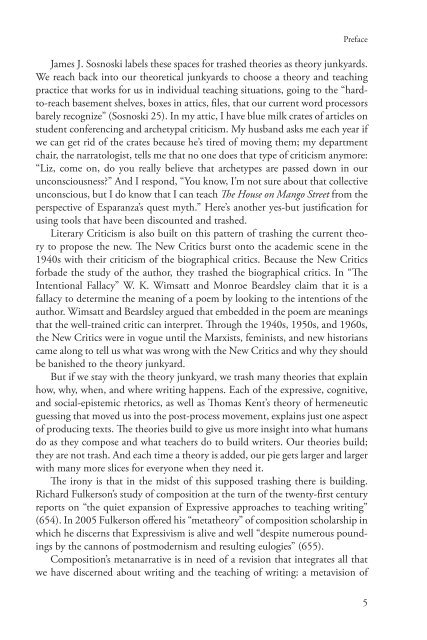Critical Expressivism- Theory and Practice in the Composition Classroom, 2014a
Critical Expressivism- Theory and Practice in the Composition Classroom, 2014a
Critical Expressivism- Theory and Practice in the Composition Classroom, 2014a
Create successful ePaper yourself
Turn your PDF publications into a flip-book with our unique Google optimized e-Paper software.
Preface<br />
James J. Sosnoski labels <strong>the</strong>se spaces for trashed <strong>the</strong>ories as <strong>the</strong>ory junkyards.<br />
We reach back <strong>in</strong>to our <strong>the</strong>oretical junkyards to choose a <strong>the</strong>ory <strong>and</strong> teach<strong>in</strong>g<br />
practice that works for us <strong>in</strong> <strong>in</strong>dividual teach<strong>in</strong>g situations, go<strong>in</strong>g to <strong>the</strong> “hardto-reach<br />
basement shelves, boxes <strong>in</strong> attics, files, that our current word processors<br />
barely recognize” (Sosnoski 25). In my attic, I have blue milk crates of articles on<br />
student conferenc<strong>in</strong>g <strong>and</strong> archetypal criticism. My husb<strong>and</strong> asks me each year if<br />
we can get rid of <strong>the</strong> crates because he’s tired of mov<strong>in</strong>g <strong>the</strong>m; my department<br />
chair, <strong>the</strong> narratologist, tells me that no one does that type of criticism anymore:<br />
“Liz, come on, do you really believe that archetypes are passed down <strong>in</strong> our<br />
unconsciousness?” And I respond, “You know, I’m not sure about that collective<br />
unconscious, but I do know that I can teach The House on Mango Street from <strong>the</strong><br />
perspective of Esparanza’s quest myth.” Here’s ano<strong>the</strong>r yes-but justification for<br />
us<strong>in</strong>g tools that have been discounted <strong>and</strong> trashed.<br />
Literary Criticism is also built on this pattern of trash<strong>in</strong>g <strong>the</strong> current <strong>the</strong>ory<br />
to propose <strong>the</strong> new. The New Critics burst onto <strong>the</strong> academic scene <strong>in</strong> <strong>the</strong><br />
1940s with <strong>the</strong>ir criticism of <strong>the</strong> biographical critics. Because <strong>the</strong> New Critics<br />
forbade <strong>the</strong> study of <strong>the</strong> author, <strong>the</strong>y trashed <strong>the</strong> biographical critics. In “The<br />
Intentional Fallacy” W. K. Wimsatt <strong>and</strong> Monroe Beardsley claim that it is a<br />
fallacy to determ<strong>in</strong>e <strong>the</strong> mean<strong>in</strong>g of a poem by look<strong>in</strong>g to <strong>the</strong> <strong>in</strong>tentions of <strong>the</strong><br />
author. Wimsatt <strong>and</strong> Beardsley argued that embedded <strong>in</strong> <strong>the</strong> poem are mean<strong>in</strong>gs<br />
that <strong>the</strong> well-tra<strong>in</strong>ed critic can <strong>in</strong>terpret. Through <strong>the</strong> 1940s, 1950s, <strong>and</strong> 1960s,<br />
<strong>the</strong> New Critics were <strong>in</strong> vogue until <strong>the</strong> Marxists, fem<strong>in</strong>ists, <strong>and</strong> new historians<br />
came along to tell us what was wrong with <strong>the</strong> New Critics <strong>and</strong> why <strong>the</strong>y should<br />
be banished to <strong>the</strong> <strong>the</strong>ory junkyard.<br />
But if we stay with <strong>the</strong> <strong>the</strong>ory junkyard, we trash many <strong>the</strong>ories that expla<strong>in</strong><br />
how, why, when, <strong>and</strong> where writ<strong>in</strong>g happens. Each of <strong>the</strong> expressive, cognitive,<br />
<strong>and</strong> social-epistemic rhetorics, as well as Thomas Kent’s <strong>the</strong>ory of hermeneutic<br />
guess<strong>in</strong>g that moved us <strong>in</strong>to <strong>the</strong> post-process movement, expla<strong>in</strong>s just one aspect<br />
of produc<strong>in</strong>g texts. The <strong>the</strong>ories build to give us more <strong>in</strong>sight <strong>in</strong>to what humans<br />
do as <strong>the</strong>y compose <strong>and</strong> what teachers do to build writers. Our <strong>the</strong>ories build;<br />
<strong>the</strong>y are not trash. And each time a <strong>the</strong>ory is added, our pie gets larger <strong>and</strong> larger<br />
with many more slices for everyone when <strong>the</strong>y need it.<br />
The irony is that <strong>in</strong> <strong>the</strong> midst of this supposed trash<strong>in</strong>g <strong>the</strong>re is build<strong>in</strong>g.<br />
Richard Fulkerson’s study of composition at <strong>the</strong> turn of <strong>the</strong> twenty-first century<br />
reports on “<strong>the</strong> quiet expansion of Expressive approaches to teach<strong>in</strong>g writ<strong>in</strong>g”<br />
(654). In 2005 Fulkerson offered his “meta<strong>the</strong>ory” of composition scholarship <strong>in</strong><br />
which he discerns that <strong>Expressivism</strong> is alive <strong>and</strong> well “despite numerous pound<strong>in</strong>gs<br />
by <strong>the</strong> cannons of postmodernism <strong>and</strong> result<strong>in</strong>g eulogies” (655).<br />
<strong>Composition</strong>’s metanarrative is <strong>in</strong> need of a revision that <strong>in</strong>tegrates all that<br />
we have discerned about writ<strong>in</strong>g <strong>and</strong> <strong>the</strong> teach<strong>in</strong>g of writ<strong>in</strong>g: a metavision of<br />
5


















